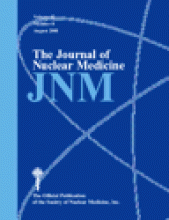Abstract
Myocardial viability was assessed by 99mTc-methoxyisobutylisonitrile (MIBI) SPECT and 18F-FDG PET to evaluate the prognosis and treatment strategy of patients with myocardial infarction (MI) and left ventricular (LV) dysfunction. Methods: One hundred twenty-three consecutive patients with previous MI and LV dysfunction (LV ejection fraction [EF], 35% ± 6% [mean ± SD]) who underwent 99mTc-MIBI SPECT and FDG PET were followed-up for 26 ± 10 mo (mean ± SD). Distributions of the 2 radiotracers in myocardial segments were classified into 2 patterns: myocardial perfusion–metabolism mismatch (MM) and match (M). LV EF and LV end-diastolic diameter (EDD) were measured by echocardiography at baseline, 3 mo (Pos1), and 6 mo (Pos2) after revascularization. Cardiac death, acute MI, unstable angina, and late revascularization (>3 mo) experienced by the patients during follow-up were defined as cardiac events. Results: Sixty-seven patients underwent revascularization and 56 patients were treated medically. Of the 72 patients with ≥2 MM segments, 42 underwent revascularization (group A1) and 30 were treated medically (group A2). Of the 51 patients with <2 MM segments, 25 underwent revascularization (group B1) and 26 were treated medically (group B2). The 4 groups had similar baseline characteristics and rest LV EF. After revascularization, EF (mean ± SD) increased in group A1 from 36% ± 5% to 44% ± 8% (P < 0.0001) in Pos1 and to 51% ± 9% (P < 0.0001) in Pos2. EDD (mean ± SD) decreased from 62 ± 8 mm to 56 ± 5 mm (P < 0.001) in Pos1 and to 55 ± 5 mm (P < 0.001) in Pos2. However, EF and EDD were unchanged in group B1 (P > 0.05). During the follow-up, 22 patients (17.9%) suffered from cardiac events, including 11 cardiac deaths, 4 acute MI, 6 late coronary artery bypass grafting, and 1 unstable angina pectoris. The cardiac event rate in group A2 (50%) was significantly higher than that of groups A1 (2.4%; χ2 = 23.08; P < 0.0001), B1 (12%; χ2 = 8.94; P = 0.003), and B2 (11.5%; χ2 = 9.45; P = 0.002). Conclusion: Assessment of myocardial viability using hybrid 99mTc-MIBI SPECT and FDG PET can predict the clinical outcome and is helpful to decision making in the treatment strategy of patients with MI and LV dysfunction. Revascularization can improve the LV function and clinical outcome of patients with >2 viable myocardial segments.
Footnotes
Received Nov. 14, 2000; revision accepted Apr. 9, 2001.
For correspondence or reprints contact: Xiu-Jie Liu, MD, Department of Nuclear Medicine, Cardiovascular Institute and Fu Wai Hospital, Chinese Academy of Medical Sciences, Peking Union Medical College, Beijing, 100037, China.







